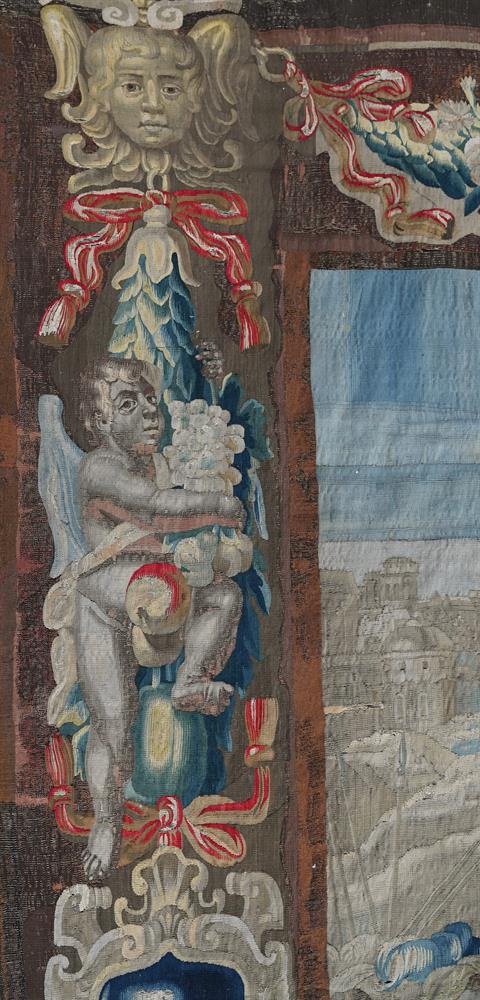A BRUSSELS HISTORICAL TAPESTRY FROM THE LIFE OF ALEXANDER THE GREAT LATE 17TH CENTURY Alexander the Great astride Bucephalus, trampling his enemies, with foreground of water's edge, soldiers on the riverbanks in the middle distance with war elephants to the left, with a hilltop citadel in the distance, within elaborate architectural border with ribbons, floral swags and winged cherubic figures and central cartouche to each edge, small unidentified weaver's mark to lower left side guard border approximately 345 x 524 cm The most important and probably influential series of scenes from the life of Alexander was originally designed by Charles le Brun between 1660 and 1673 for Louis XIV, and initially woven by the King's weavers at the Royal Tapestry of Les Gobelins. The Alexander series was the first major new tapestry commission of Louis XIV's reign, and the tapestries were designed to flatter the king by comparing his virtues and achievements to those of Alexander the Great. The success of the designs led to other versions being produced by weavers such as the Aubusson factories, Judocus de Vos, and the Felletin weavers in the region of Le Marche. The use of Alexander as a suitable subject matter pre-dates le Brun's designs however and by the end of the 17th century onwards, factories took to producing their own versions, interpolating elements from earlier designs with le Brun's iconography to produce new scenes from his life. It would seem that this tapestry is one such example of this type. It draws on elements from various sources which depict one of two significant successful battles in his life; either the Battle of Granicus in 334BC, or the Battle of Gaugamela in 331BC. The first is suggested by the river setting, the second by the war elephants and the broader landscape- both details recorded in Plutarch's Life of Alexander. It is probable that the weaver's design is drawn, in part, from a set executed by the workshop of Karel van Mander the Younger (1579-1623) in the early 17th century. One such panel is held in the Art Institute of Chicago collection and depicts "The Crossing of the Granicus" (1911.439). It is possible that the fortified buildings on the mountain in the distance and Alexander's horses pose are directly influenced by this panel. In overall style and with distinctive cherub pillar supports flanking swags to the main borders, it is perhaps from the workshop that produced the Flemish 17th century tapestry attributed to the Van Maelsack Atelier Bruxelles and which depicted Alexander the Great astride Bucephalus, sold Bonham's London, Fine Decorative Arts, 1200-1900, 18 December 2020, lot 29. Interestingly it also carried a similar atelier symbol to the left hand guard.
A BRUSSELS HISTORICAL TAPESTRY FROM THE LIFE OF ALEXANDER THE GREAT LATE 17TH CENTURY Alexander the Great astride Bucephalus, trampling his enemies, with foreground of water's edge, soldiers on the riverbanks in the middle distance with war elephants to the left, with a hilltop citadel in the distance, within elaborate architectural border with ribbons, floral swags and winged cherubic figures and central cartouche to each edge, small unidentified weaver's mark to lower left side guard border approximately 345 x 524 cm The most important and probably influential series of scenes from the life of Alexander was originally designed by Charles le Brun between 1660 and 1673 for Louis XIV, and initially woven by the King's weavers at the Royal Tapestry of Les Gobelins. The Alexander series was the first major new tapestry commission of Louis XIV's reign, and the tapestries were designed to flatter the king by comparing his virtues and achievements to those of Alexander the Great. The success of the designs led to other versions being produced by weavers such as the Aubusson factories, Judocus de Vos, and the Felletin weavers in the region of Le Marche. The use of Alexander as a suitable subject matter pre-dates le Brun's designs however and by the end of the 17th century onwards, factories took to producing their own versions, interpolating elements from earlier designs with le Brun's iconography to produce new scenes from his life. It would seem that this tapestry is one such example of this type. It draws on elements from various sources which depict one of two significant successful battles in his life; either the Battle of Granicus in 334BC, or the Battle of Gaugamela in 331BC. The first is suggested by the river setting, the second by the war elephants and the broader landscape- both details recorded in Plutarch's Life of Alexander. It is probable that the weaver's design is drawn, in part, from a set executed by the workshop of Karel van Mander the Younger (1579-1623) in the early 17th century. One such panel is held in the Art Institute of Chicago collection and depicts "The Crossing of the Granicus" (1911.439). It is possible that the fortified buildings on the mountain in the distance and Alexander's horses pose are directly influenced by this panel. In overall style and with distinctive cherub pillar supports flanking swags to the main borders, it is perhaps from the workshop that produced the Flemish 17th century tapestry attributed to the Van Maelsack Atelier Bruxelles and which depicted Alexander the Great astride Bucephalus, sold Bonham's London, Fine Decorative Arts, 1200-1900, 18 December 2020, lot 29. Interestingly it also carried a similar atelier symbol to the left hand guard.
.jpg)

.jpg)



.jpg)







Try LotSearch and its premium features for 7 days - without any costs!
Be notified automatically about new items in upcoming auctions.
Create an alert